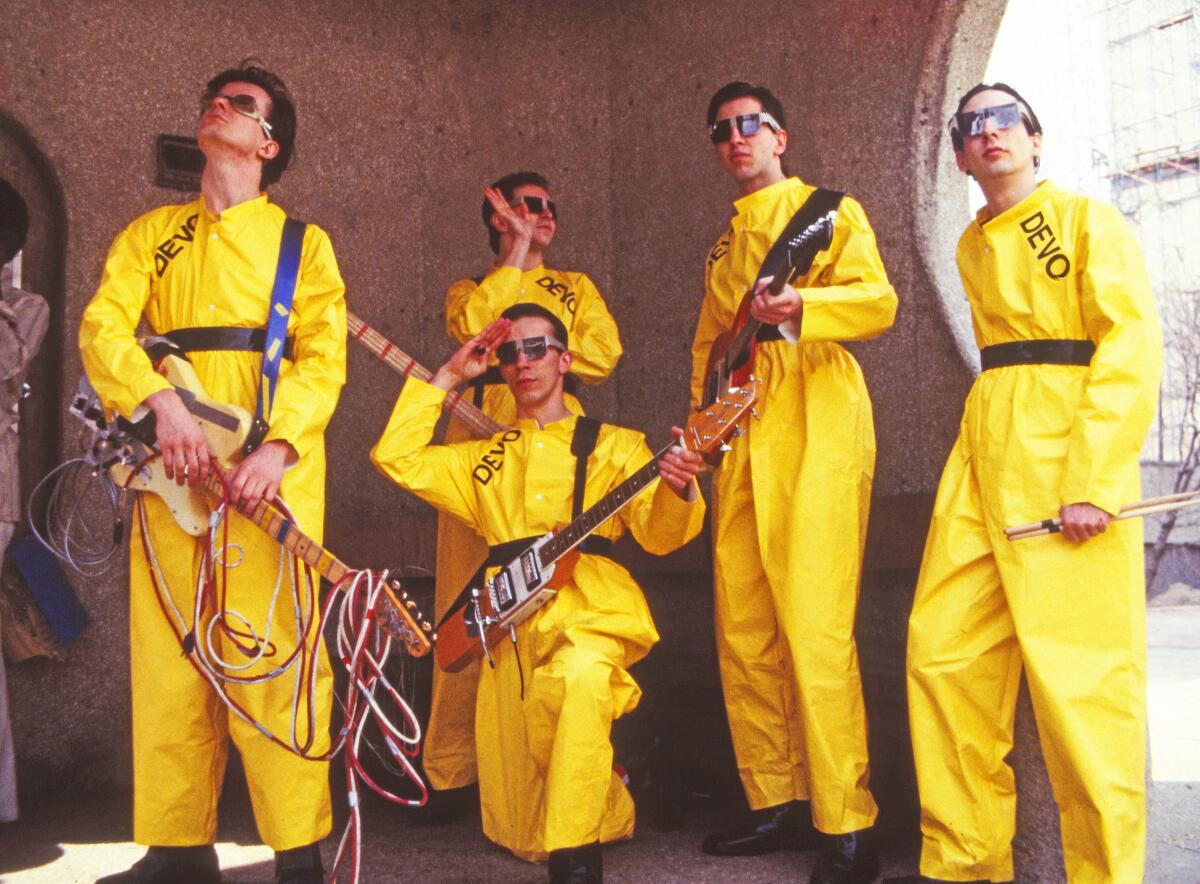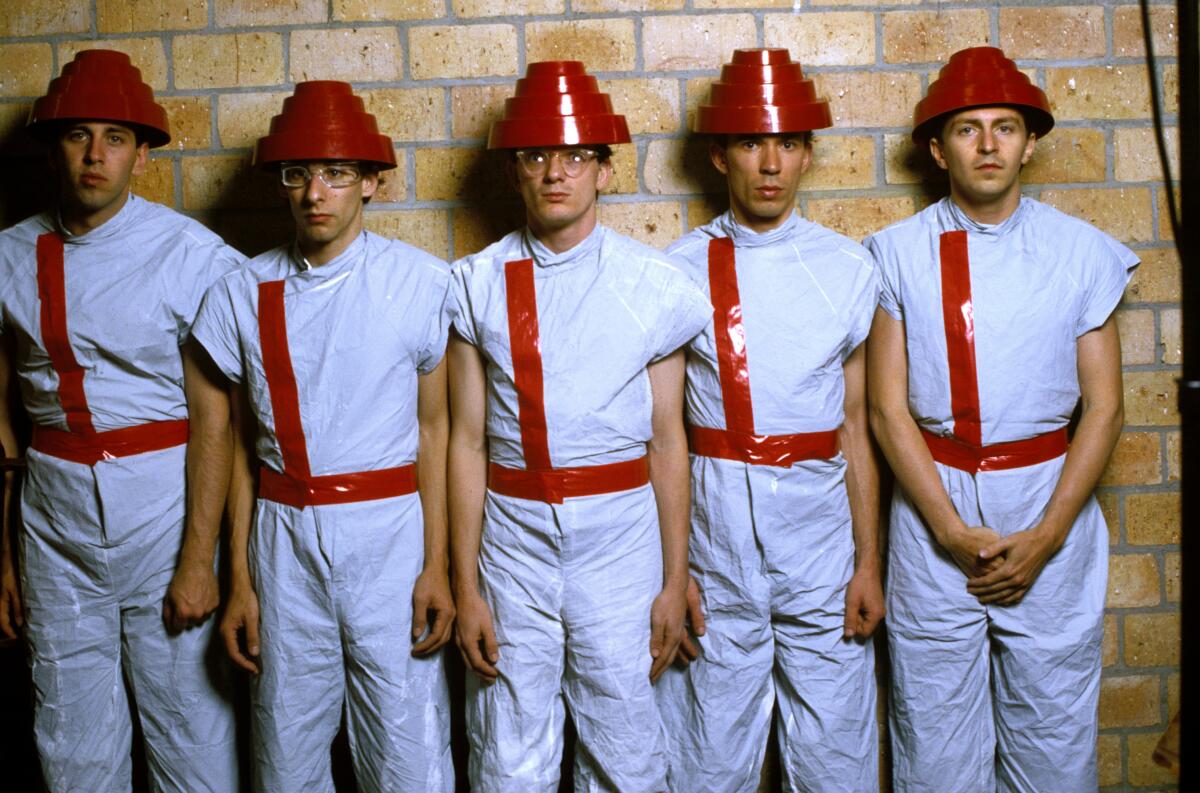Still whipping it good, Devo looks back on 50 years via a new Sundance documentary

With their yellow radiation suits, red “energy dome” hats and manic energy, part playful and part angry, the band Devo combined the futuristic glamour of new wave with atomic-age anxieties and post-’60s disillusionment. Its biggest hit, 1980’s “Whip It,” injected subversive satire straight into the heart of the American cultural mainstream.
A definitive new documentary about the group, “Devo,” has its world premiere at Sundance tonight. The film is directed by Chris Smith, whose prior work, including “American Movie,” “Tiger King” and “Sr.,” makes him no stranger to the worlds of eccentrics and oddballs.
Devo celebrated its 50th anniversary in 2023. The band first emerged from Ohio, formed by two sets of brothers — Mark Mothersbaugh and Bob Mothersbaugh and Gerald Casale and Bob Casale — plus eventual drummer Alan Myers. Their debut album, 1978’s “Q: Are We Not Men? A: We Are Devo!” was produced by Brian Eno and featured a deconstructed cover version of the Rolling Stones’ “(I Can’t Get No) Satisfaction.” From the very beginning (and presciently), they intertwined their music with film and video — much of it now restored and soon to be celebrated at the Museum of Modern Art.
Uniquely, the band developed a fully formed, intricate internal philosophy and mythology built around the idea that humans were “de-evolving” by becoming dumber and less sophisticated. The mascot of the band, known as “Booji Boy,” was an infantile urchin in a rubber mask.
Prior to the festival, director Smith and band members Gerald Casale, Bob Mothersbaugh and Mark Mothersbaugh got on a video call together for a conversation about the film.
Was there an idea to document the band right from the very start? It‘s incredible that there’s footage of the very first show in 1973.
GERALD CASALE: We were that delusional, yes. And we were trying to document ourselves when nobody was interested in doing that. And when it was quite expensive and clumsy to do it. You’re dealing with Sony U-matic reel-to-reel recorders and big heavy cameras and a scarcity of equipment and very little interest. I mean, my God, if a Devo of now existed like we did, then clearly, there’d be a million cellphone videos.
MARK MOTHERSBAUGH: Everybody has a phone with a camera, but back in those days, that was not the case. We were lucky there was a guy named Ed Barger, who was our first sound man and engineer. He had one of those units that made the stuff that looked like security-film footage. And he documented everything for us. That was fortuitous.
All of us were visual artists. Bob was the first of us to direct a video, back when he was in high school. Bob and me, our dad, starting when we were like babies, like 1 year old, he’d bring out an 8-millimeter camera that didn’t have sound, and so he shot hundreds and hundreds of these films through the years, just family stuff. So we always kind of liked that. And Jerry was doing films at Kent State with Chuck Statler before Chuck said, “Hey, let’s do a film with a couple of the songs in it.” So we were always audio-visual. We were always thinking in both worlds.

Can you talk a little bit about what you think the importance was that you guys were from Ohio, not from New York or L.A.?
BOB MOTHERSBAUGH: I think the important thing about being from Ohio was just that we had a couple years to hone our show. We tried a lot of different things in the clubs. Some didn’t work as well as others. But we learned to play together really well and put on a great show and look good before we were thrown in front of the media.
When most bands would just sort of shamble onstage in their street clothes, you guys really put on a proper show, a presentation with choreography. Where did that impulse come from?
MARK MOTHERSBAUGH: We all talked about being theatrical and being almost like a cabaret. If you’re talking about something like “Uncontrollable Urge,” we were just in a basement where we could barely fit in it. So doing that step that we did, doing it in unison, that was just all you could really accomplish in a basement. Jerry found footage of Watusi Indians doing a thing that we incorporated into “Snowball.”
GERALD CASALE: “Uncontrollable Urge” was the [Muhammad] Ali Shuffle. That’s what it was. Like, “Hey, let’s do like Ali right here in this part of the song.”
CHRIS SMITH: One of my favorite details in looking through the old footage is, there’s an early show that was recorded in black-and-white, and they have such limited materials to work with, yet they do this thing where the light goes on and off on both sides of the stage. And to me it was so emblematic of where they were going because they were making something that you hadn’t seen before that was super creative and visually distinctive and interesting out of something we all had to work with. We all could use those lights, but their movements with the lights is one of my favorite moments in the movie. And that was right at the outset. You could see in that footage, the inventiveness that wasn’t a result of means — it was something that was just created out of what they had to work with at that time.
GERALD CASALE: That’s what a good artist would do, right? Take limited resources and do something interesting with them. If you can’t use eight crayons to create something interesting, 64 isn’t going to help you. It was a do-it-yourself aesthetic. And so we did minimalism. We had studied minimalism from the ’20s and ’30s to begin with.
MARK MOTHERSBAUGH: Sonically, a lot of what we did was just related to the fact that Bob Mothersbaugh bought a four-track TEAC. So we had this machine that could record four little skinny channels on a quarter-inch tape. It was an amateur home-tape machine, but it made us think about our parts, because we thought, well, OK, you’re only going to get to do the bass on one track, and the guitar on one track and the drums on one track and the synth. You’re not going to do all these overdubs. We had to think about it, what was an essential part. So we’d work on the song till you could play it just in one pass. Everything essential. I think it really made the early stuff sound really strong because of that.
Can you talk about the idea of de-evolution, having this whole ethos and mythology behind the band itself?
GERALD CASALE: That just came from such dissatisfaction with the kind of mainstream propaganda where you find out everything you’ve been told growing up is basically a big lie because it doesn’t explain reality and it doesn’t explain human nature. So de-evolution was like a tongue-in-cheek intellectual rebuttal of the mainstream narrative about how human beings are the greatest and the top species on planet Earth. We looked at it more like Martians in a spaceship looking down on the planet, going: “That species there is really dangerous and really f—ed up. And look what they’re doing to every other living thing on the planet. They’re out of harmony with it.” We just started recalculating everything from an upside-down view of reality and thought this makes more sense. It explains reality better than what you’ve been taught.
MARK MOTHERSBAUGH: There were books in 1969 that warned us about humans — we’re the unnatural species. “The Population Bomb,” I remember reading that when I was a sophomore at Kent [State University]. And basically it just said that planet Earth is going to have to find a way to protect itself from humans. And he predicted in this book that by the year 2050, there would be a virus that would wipe out humans and save the Earth. Everybody made fun of it.
There were all these serious ideas and concepts behind the band, but people just thought you were funny and weird. Was the band misunderstood?
BOB MOTHERSBAUGH: Sometimes in Akron, when we would play shows, we would gauge how good we were by how angry the audience got. It was like, well, if they didn’t like us, they would leave. Instead they got mad and started threatening us. So we’d say, we got something.
GERALD CASALE: It just made us more resolved to do it more.
Mark, do you feel the more serious ideas behind the band were overlooked?
MARK MOTHERSBAUGH: We always knew that there was that possibility, especially once “Whip It” came out. People totally misinterpreted what that was about. But the good thing about a song like “Whip It” is if it gets people to listen to the albums, then they’re hearing “Freedom of choice is what you want / Freedom from choice is what you got.” So maybe they hear that and then go, what does that mean?

It’s rare to see a movie of this type where the subjects are so candid about record-company hassles and internal struggles within the band. Chris, did it take any convincing for them to open up like that?
CHRIS SMITH: No.
MARK MOTHERSBAUGH: But you have to also realize how far we are away from those days now. So it’s like, what’s going to happen? The record company’s going to not push a single that we are not putting out, that we don’t even have to worry about?
GERALD CASALE: And that we are not signed to.
BOB MOTHERSBAUGH: “Spinal Tap” wasn’t made in a vacuum.
GERALD CASALE: They call that a mockumentary, but it was actually the most truthful documentary I’ve ever seen.
If the band was always subverting the machine from the inside, did you find at some point that you were still part of the machine and you were having the same problems you were trying to fight against in the first place?
MARK MOTHERSBAUGH: Yeah, of course. It’s a two-edged sword. And we got to a place where we were using more sophisticated and more amazing equipment, and then it just started sounding more like other bands, too.
GERALD CASALE: But that dynamic’s always been true. It’s delusional to think that you’re not going to be part of the machine. An artist has to think that on some level to remain creative and remain relevant. It’s like the TV series from the ’60s, “The Prisoner” — he keeps trying to get out of the village and there’s no getting out of the village.
MARK MOTHERSBAUGH: We had to sync up with the entertainment industry, because otherwise I remember sitting in my little one-room apartment going, I wonder what it’s going to be like if I’m 40 and I’m still sitting in this room writing music, and then there’ll just be a hundred more boxes of tape on the wall. Nobody would’ve heard us. And so we purposely came out to California to test our aesthetic and see if we could do it and still be part of the entertainment industry.
Bob, having two such strong creative figures in Mark and Gerald, how did that dynamic work itself out?
BOB MOTHERSBAUGH: I don’t know that there was anything to work out. It was just: We were friends and we played together.
GERALD CASALE: And I think the brothers made it shorthand and the two sets of brothers created parity.
MARK MOTHERSBAUGH: And nobody thought of it as competition.
GERALD CASALE: If somebody did something interesting, we all responded. You knew when you heard something cool, because we were all on the same page.
What has making this film meant to you? Do you see it as part of a larger 50th anniversary project? Are you kind of wrapping up the band?
GERALD CASALE: I don’t know what a documentary has to do with closure. It’s definitely a rest stop on the road to oblivion. It’s one documentary and it’s Chris’ idea. In other words, if you give 10 directors the same archival footage and the same interviews, you will get 10 completely different documentaries.
CHRIS SMITH: I never looked at it as a project that was putting closure to this band in any way whatsoever. It was an interesting story that, to me, was continuing, and this was just one element of a much bigger creative tapestry. I never went into it with the thought that this was some bookend. They’re still touring. They’re all still actively creatively pursuing many different things, as I hope that you would expect after seeing the film.
MARK MOTHERSBAUGH: Booji Boy describes it as a halfway point to the year of 2073, where we’ll celebrate the 100-year anniversary. And he’s saying that the second 50 years will be more about action. And it’ll be about positive mutation. Mutate, don’t stagnate.
More to Read
Only good movies
Get the Indie Focus newsletter, Mark Olsen's weekly guide to the world of cinema.
You may occasionally receive promotional content from the Los Angeles Times.











